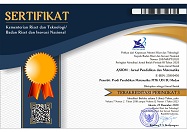Student errors in solving system of linear equations in two variables story problems based on Newman error analysis
Abstract
The purpose of this study was to describe the types of errors and their causes made by eighth-grade students in solving system of linear equations in two variables (SLETV) problems and to propose solutions to overcome them using the NEA (Newman Error Analysis) procedure. The research method used was descriptive research with a qualitative approach. In this study, data collection involved tests and interviews. The test instrument included a written test with two story problems related to SLETV material in the form of essays. At the same time, interviews were conducted with teachers as a preliminary study and with selected students to determine the types of errors made in solving the given questions. The researcher selected three students as research subjects from all students in class VIII A who made various errors in the interview questions, with one student chosen additionally for their good communication skills. The results showed that the stage with the lowest error rate fell within the sufficient and good categories. Conversely, the answer-writing stage exhibited a high error rate, as all students fell into the less capable category
Keywords
Full Text:
PDFReferences
Abdurrahman, M. (2012). Anak berkesulitan belajar teori, diagnosis, dan remediasinya. Rineka Cipta.
Amir, Z. (2015). Mengungkap seni bermatematika dalam pembelajaran. Suska Journal of Mathematics Education, 1(1), 60. https://doi.org/10.24014/sjme.v1i1.1364
Anggelina, M., Rosyidah, U., & Setyawati, A. (2023). Analisis kemampuan siswa menyelesaikan soal matematika berbentuk cerita pada siswa kelas x smk negeri 1 pekalongan. Jurnal Ilmiah Matematika Realistik, 4(1), 89–95.
Arikunto, S. (2016). Prosedur penelitian. Rineka Cipta.
Ayu, M.S., Susiswo, S., & Sa’dijah, C. (2023). Proses berpikir kritis siswa dalam memecahkan masalah matematika. AKSIOMA: Jurnal Program Studi Pendidikan Matematika, 12(3), 3075. https://doi.org/10.24127/ajpm.v12i3.7508
Benyamin, B., Qohar, A., & Sulandra, I.M. (2021). Analisis kemampuan berpikir kritis siswa sma kelas x dalam memecahkan masalah spltv. Jurnal Cendekia : Jurnal Pendidikan Matematika, 5(2), 909–922. https://doi.org/10.31004/cendekia.v5i2.574
Boelens, R., Voet, M., & Wever, B. De. (2018). The design of blended learning in response to student diversity in higher education: instructors’ views and use of differentiated instruction in blended learning. Biomass Chem Eng, 3(2), ثقثقثقثق. http://doi.org/10.1016/j.compedu.2018.02.009 To
Fitriatien, S.R. (2019). Analisis kesalahan siswa dalam menyelesaikan soal cerita matematika berdasarkan prosedur newman. Lentera Sriwijaya : Jurnal Ilmiah Pendidikan Matematika, 1(2), 1–12. https://doi.org/10.36706/jls.v1i2.9707
Fitriatien, S.R. (2022). Analisis kesalahan dalam menyelesaikan soal teorema bayes. JIPMat: Jurnal Ilmiah Pendidikan Matematika, 4(1), 59–67. https://doi.org/10.26877/jipmat.v4i1.3550
Iriani, A., Sridana, N., Triutami, T.W., & Azmi, S. (2022). Analisis kesalahan dalam menyelesaikan soal integral taktentu dengan metode newman ditinjau dari kemampuan matematis. Griya Journal of Mathematics Education and Application, 2(4), 1072–1084. https://doi.org/10.29303/griya.v2i4.257
Khoirunnisa, K., & Amidi. (2022). Kajian teori : pengembangan bahan ajar berbasis outdoor learning dengan model connected mathematics project ( cmp ) dan pendekatan saintifik untuk meningkatkan kemampuan koneksi matematis. Prisma Prosiding Seminar Nasional Matematika, 5, 559–564.
Linola, D.M., Marsitin, R., & Wulandari, T.C. (2017). Analisis kemampuan penalaran matematis peserta didik dalam menyelesaikan soal cerita di sman 6 malang. Pi: Mathematics Education Journal, 1(1), 27–33. https://doi.org/10.15797/concom.2019..23.009
Mauliandri, R., & Kartini, K. (2020). Analisis kesalahan siswa menurut kastolan dalam menyelesaikan soal operasi bentuk aljabar pada siswa smp. AXIOM : Jurnal Pendidikan Dan Matematika, 9(2), 107–123. https://doi.org/10.30821/axiom.v9i2.7687
NCTM. (2014). Principles to actions: ensuring mathematical success for all. The National Council of Teachers of Mathematics.
Newman, F.M. (1977). An analysis of sixth-grade pupil’s error on written mathematical tasks. Victorian Institute for Educational Research Bulletin, 39(1), 31–43.
Newmann, F.M., & Wehlage, G.G. (1993). Five Standards of Authentic Instruction. Educational Leadership, 50(7), 8–12.
Norton, A., Ulrich, C., & Kerrigan, A. (2023). Unit transformation graphs: modeling students’ mathematics in meeting the cognitive demands of fractions multiplication tasks. National Council of Teachers of Mathematics (NCTM), 54(4), 240–259. https://doi.org/10.5951/jresematheduc-2021-0031
Nurhayati, A.S. (2022). Analisis kesalahan siswa smp dalam menyelesaikan soal pada materi aritmatika sosial. Apotema: Jurnal Program Studi Pendidikan Matematika, 6(1), 54–66. http://publikasi.stkippgri-bkl.ac.id/index.php/APM/article/view/153
Nurhayati, N., Subanji, S., & Rahardjo, S. (2022). Proses pemecahan masalah sistem persamaan linear dua variabel berdasarkan tahapan mason ditinjau dari tipe adversity quotient. Jurnal Cendekia : Jurnal Pendidikan Matematika, 6(1), 615–634. https://doi.org/10.31004/cendekia.v6i1.1239
Ramlah, R., Bennu, S., & Paloloang, B. (2017). Analisis kesalahan siswa dalam menyelesaikan soal penjumlahan dan pengurangan pecahan di kelas vii smpn model terpadu madani. JIPMat: Jurnal Ilmiah Pendidikan Matematika, 1(2), 182–194. https://doi.org/10.26877/jipmat.v1i2.1245
Rosaliza, M. (2015). Wawancara: sebuah interaksi komunikasi dalam penelitian kualitatif. Jurnal Ilmu Budaya, 11 (2), 71-79. https://doi.org/10.31849/jib.v11i2.1099
Saclarides, E.S.L., & Theule, S. (2021). Teachers’ mathematics learning opportunities during one-on-one coaching conversations. National Council of Teachers of Mathematics (NCTM), 52(3), 250–256. https://doi.org/10.5951/jresematheduc-2020-0092
Sugiyono. (2010). Metode Penelitian Kuantitatif, Kualitatif dan R&D. Bandung: Alfabeta.
Sukoriyanto, & Afandi, A.F. (2023). The creative thinking process of 8th grade junior high school students in solving sequence of number problems based on wallas theory. AIP Conference Proceedings, 2569(1). https://doi.org/ 10.1063/5.0112370
Sunardiningsih, G. W., Hariyani, S., & Fayeldi, T. (2019). Analisis kesalahan siswa dalam menyelesaikan soal matematika berdasarkan analisis newman. RAINSTEK : Jurnal Terapan Sains & Teknologi, 1(2), 41–45. https://doi.org/10.21067/jtst.v1i2.3447
Syamsuadi, A., Darmadi, M. F., & Dassa, A. (2021). Analisis kesalahan siswa dalam menyelesaikan soal SLETV berorientasi pisa dengan konten change and relationship pada kelas viii smp unismuh makassar. Sigma: Jurnal Pendidikan Matematika, 13(2), 103–118. https://doi.org/10.26618/sigma.v13i2.6316
Upu, H., Dassa, A., & R., N. (2022). Analisis kesalahan siswa dalam menyelesaikan soal materi sistem persamaan linear dua variabel ditinjau dari kemampuan awal matematika. Issues in Mathematics Education (IMED), 6(1), 83–98. https://doi.org/10.35580/imed32233
Utami, R.W., Endaryono, B.T., & Djuhartono, T. (2020). Meningkatkan kemampuan berpikir kreatif. Faktor Jurnal Ilmih Kependidikan, 7(1), 43–48.
DOI: http://dx.doi.org/10.30821/axiom.v13i1.18227
Refbacks
- There are currently no refbacks.
Copyright (c) 2024 zakiyah fatah

This work is licensed under a Creative Commons Attribution-ShareAlike 4.0 International License.
p-ISSN: 2087-8249 | e-ISSN: 2580-0450
Indexed by:
AXIOM : Jurnal Pendidikan dan Matematika is licensed under a Creative Commons Attribution-ShareAlike 4.0 International License.











